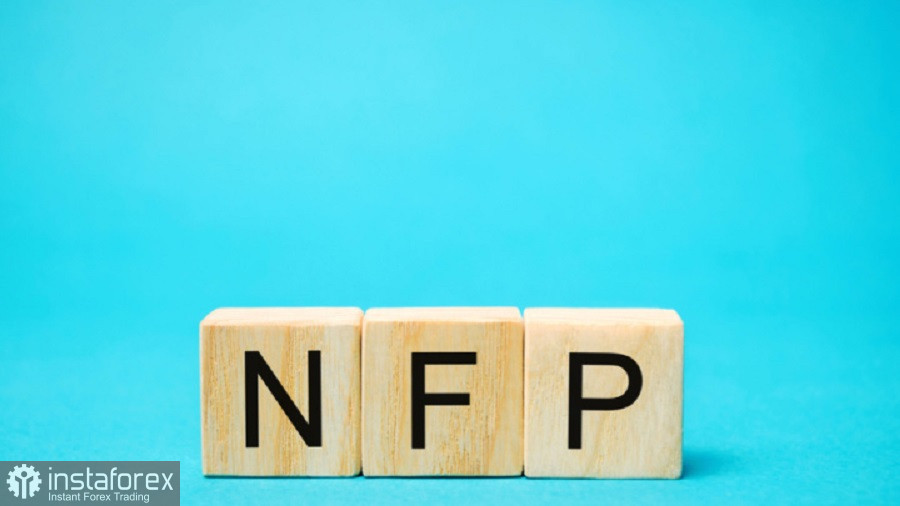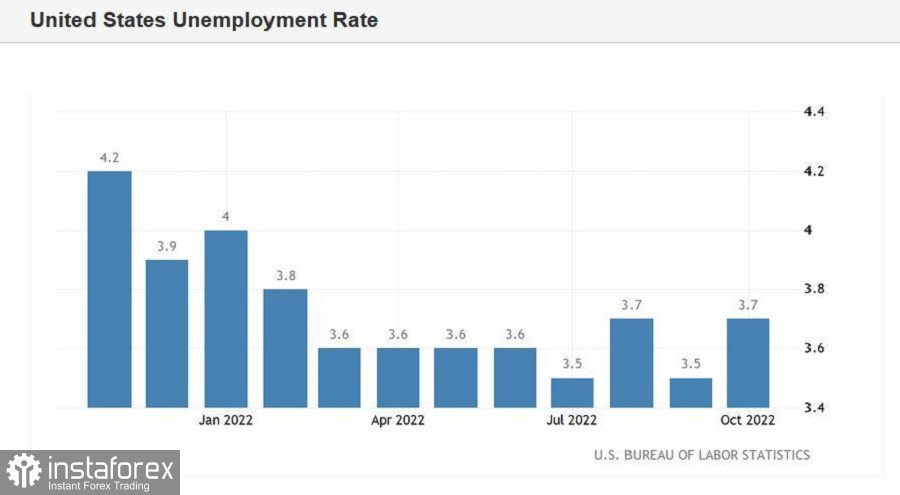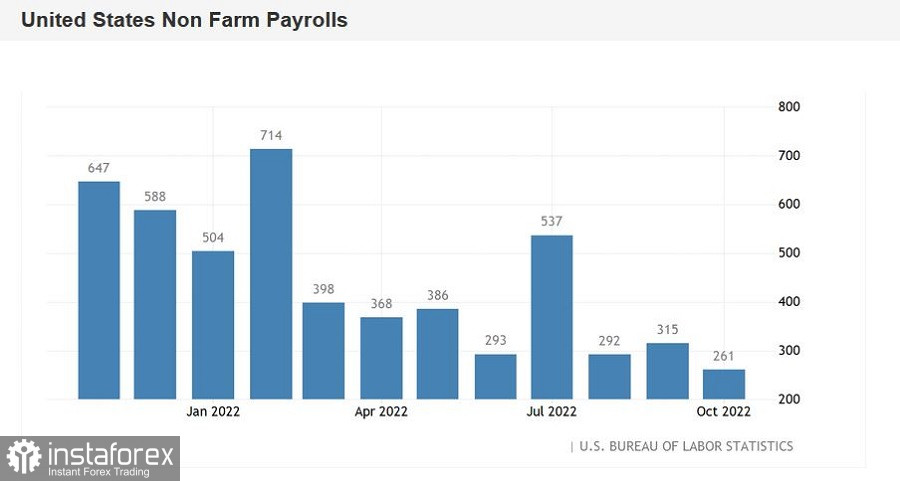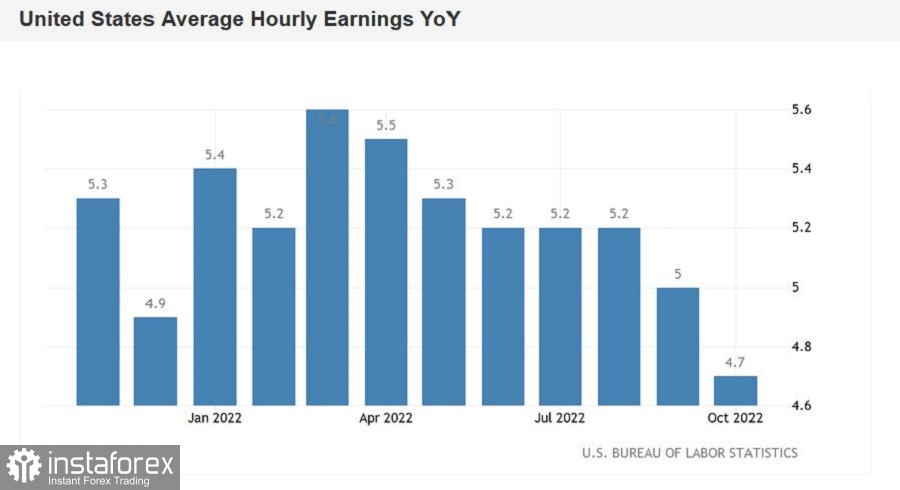The data on the growth of the US labor market, published on Friday, turned out to be very controversial, and rather negative for the greenback. An unexpected rise in unemployment, a slowdown in the growth of average wages, a decrease in the share of the economically active population - all these factors offset the fighting spirit of the bears on the EUR/USD pair. At the same time, the rate of growth in the number of employees pleasantly surprised investors - this component significantly exceeded the forecast levels. However, the overall impression of the release is negative.

Although in general there is nothing catastrophic in the figures. And even more so, the report will not affect the hawkish mood of the members of the Federal Reserve. With only one caveat: the pace of tightening the Fed's monetary policy may be slowed down as early as December (and not in February). Apparently, this conclusion serves as an anchor for the US currency. Plus - the notorious "Friday factor", which forces traders to close "unreliable" trading positions, in particular, shorts on the EUR/USD pair.
Such circumstances extinguished the downward momentum, which was observed after the announcement of the results of the Fed's November meeting. The question is for how long? After all, the market was already partly ready for the fact that the Fed would slow down in the coming months. Whereas the greenback's trump card is now another fundamental factor. Fed Chairman Jerome Powell has made it clear that the rate will peak above the 5% level, while the speed of reaching the new target (approximately 5.25%) is no longer "so important."
Actually, for this reason, on Thursday, traders ignored Powell's words that the pace of the rate hike will be slowed down "in December or February" (this issue will be decided at the December meeting). Naturally, after the Nonfarm report was released, the scales will gradually tip in favor of December. But in the context of the overall results of the Fed's November meeting, this fact is not critical for the US currency.
According to the CME FedWatch Tool, there is now a 52% chance of a 50-point rate hike at the December meeting. Accordingly, the 75-point scenario has a 48% chance. But take note that before the Nonfarm report was released (and after the announcement of the results of the November meeting), the ratio was 51/49. This suggests that traders are still hesitating between the two options, and the US labor market has not played a decisive role here.
Therefore, in my opinion, Friday's upward breakthrough is more of an emotional character. It is also worth considering that many traders, apparently, decided to take profits ahead of the weekend, thereby provoking a corrective rollback of EUR/USD.
But back to Friday's report. The unemployment rate rose slightly - to the mark of 3.7% from the previous value of 3.5%. The average hourly wage increased by 4.7% (in annual terms), having decreased from the previous value of 5.0%. The share of the economically active population is minimal, but still decreased, to 62.2%. All of the above indicators came out in the red zone. On the other hand, the increase in the number of employees, on the contrary, exceeded the forecast levels. In the non-agricultural sector, the indicator rose by 261,000 against the forecast for an increase of 190,000 (September's figure was revised upward to 315,000). In the private sector of the economy, 233,000 jobs were created (forecast - 200,000), in the manufacturing industry 32,000 (with a forecast of growth of 15,000).



Of course, the October Nonfarm did not become an ally of the US currency. After Friday's release, the market will increasingly and louder say that the Fed will raise the rate by only 50 basis points in December, reacting to the slowdown in major economic indicators. This factor will (and is already exerting) temporary pressure on the US dollar.
But, I repeat, the very fact of a slowdown in the tightening of the monetary policy will not be able to reverse the EUR/USD trend. After all, Powell not only announced that the central bank is aiming for a higher level of the key rate in the medium term. He made it clear that the Fed will stop tightening monetary policy only when it is sufficiently confident that inflation is noticeably and consistently declining. And speaking directly about the EUR/USD pair, here it is necessary to recall the position of the European Central Bank on this issue. Back in September, ECB President Christine Lagarde outlined the time frame for the process of tightening the monetary policy - according to her, the central bank will raise rates in several meetings - "from two to five." At the same time, Mario Centeno, a member of the Board of Governors of the ECB, said that the central bank "has already carried out most of the necessary rate hikes to curb inflation in the eurozone."
All this suggests that Friday's upward movement was of a corrective nature, moreover, reinforced by the notorious "Friday factor". It was not advisable to open short positions at the end of Friday, but if we consider the medium-term prospects, then, in my opinion, the downward trend has not yet exhausted itself. Take note that in order to develop the bullish attack, EUR/USD bulls need not only to overcome the parity level, but also to settle above 1.0050 (the upper line of the Bollinger Bands on the daily chart). In the current fundamental conditions, this looks unlikely.
 Bahasa Indonesia
Bahasa Indonesia 
 Русский
Русский English
English Bahasa Malay
Bahasa Malay ไทย
ไทย Español
Español Deutsch
Deutsch Български
Български Français
Français Tiếng Việt
Tiếng Việt 中文
中文 বাংলা
বাংলা हिन्दी
हिन्दी Čeština
Čeština Українська
Українська Română
Română

